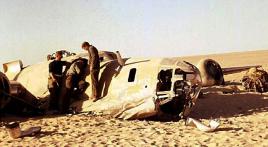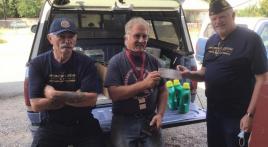Not a man shrunk from the conflict
Lieut. Colonel Armistead, Sept. 24th, 1814
By S Culshaw
In July, we will celebrate our nation's 241st birthday (measured from the signing of the Declaration of Independence). And I, like most of you, will take in the local fireworks displays. All 20 minutes. During this time, "The Star-Spangled Banner" will be playing in the background.
But how many of you know that the words in the song tie into the fireworks overhead? There is a connection. They both commemorate the 25-hour bombardment of Fort McHenry.
So why celebrate a battle that took place over 200 years ago? There are two reasons. First, the battle was a turning point in the Revolutionary War. Why? British troops had planned to seize Baltimore's harbor. This was a militarily strategic and critical shipping port. Their plan failed because of the bravery of colonial troops manning Fort McHenry and guarding the city.
Second, the battle let the British know our forefathers would not go down without a fight. A tradition that carries on to this day.
Just before British troops ships sailed for Fort McHenry, the British captured and burned Washington, D.C. to the ground. Vice Admiral Sir Alexander Cochrane and Major General Robert Ross assumed they would have similar success in Baltimore. They intended to capture the port city and use it as a base for military operations. Fort McHenry was the only obstacle in their way.
In the first weeks of September 1814, 30 British ships sailed towards Baltimore. The attack strategy was simple. The fleet would split ten miles outside of the city. Half the fleet with 4500 British troops would anchor ten miles away from the city. The troops would then make their way overland to Baltimore. Once there they would attack and seize the city. They would then occupy the fort. But for the plan to succeed, British ships would have to drive colonial forces from Fort McHenry.
Their plan should have succeeded. After all, British ships were outfitted with new long-range cannons. These cannons could lob shells over two miles. Almost twice the distance of the cannons at the fort. This would allow the ships to stay well out of range of McHenry's cannons.
On the 13th, 16 heavily armed British ships sailed within two miles of McHenry and begin bombarding the fort. Artillery crews in the fort returned fire. But soon realized their cannons' rounds were falling far short of the British ships. All the troops inside the fort could do from then was on hunker down and pray.
The bombardment of Fort McHenry lasted 25 hours. During this time, roughly 1800 rounds burst in and around the fort. In the words of Lieut. Colonel Armistead (Commanding officer of the fort):
A large proportion burst over us, throwing their fragments among us, and threatening destruction. Many passed over, and about four hundred fell within the works (inside the fort).
Francis Scott Key, a prisoner aboard one of the ships, described the scene in these words:
O’er the ramparts we watched were so gallantly streaming?
And the rocket’s red glare, the bombs bursting in air,
Gave proof through the night that our flag was still there.
Gave proof that our flag was still there. This is not what Vice Admiral Cochrane wanted to see. Why? Military tradition calls for troops to strike their colors (flag) when they abandon a fort. Our flag was still flying. That meant Fort McHenry was still manned by colonial troops.
If you are having a hard time imagining what it was like inside the fort during the bombardment, try this exercise. As you watch the fireworks on the Fourth, imagine the large mortar rounds going off not a hundred to 200 feet above your head, but 10 to 30 feet. Some will be going off directly behind you as well. Your body vibrates with each explosion. Gunpowder fills your nostrils and you are hit by flying debris from all sides. Much similar to debris from a tornado pelting your face and body. 72 rounds per hour – one per minute.
Now here's the fun part. This state of affairs would last not 20 minutes like on the Fourth. But for more than a day. No sleep. No quiet. Just the continuous explosions and vibrations of artillery shells exploding all around you for 25 hours. Would you stay and hold your ground? The troops manning Fort McHenry stayed. Lieut. Colonel Armistead later noted their bravery with a simple phrase, “Not a man shrunk from the conflict.”
They not only stayed. They chanced certain death by leaving cover to open fire on several British ships. The ships were trying to use the cover of darkness and the bombardment to sail into Harbor. The ships were driven back by cannon fire from the fort.
As the sun rose over the fort on the 14th. There was a light mist obscuring the fort. But as the mist cleared, Cochrane realized his plan had failed. How? He could see our nation’s flag was still flying over the fort. This meant colonial troops still manned the fort and it's cannons.
Even worse, Cochrane had no more rounds for his long-range cannons. This meant his ships would have to sail within range of the fort's artillery to continue the bombardment. And those fort cannons were deadly accurate.
British ground troops were also prevented from taking Baltimore by by a small band of colonial soldiers.
Francis Scot Key described the scene in these words:
On the shore, dimly seen through the mists of the deep,
Where the foe’s haughty host in dread silence reposes,
What is that which the breeze, o’er the towering steep,
As it fitfully blows, half conceals, half discloses?
Now it catches the gleam of the morning’s first beam,
In full glory reflected now shines in the stream:
‘Tis the star-spangled banner!
Our flag was still flying!
At this point, Vice Admiral Cochrane had only two choices. He could sail his fleet within range of the fort's cannons. Or he could withdraw his fleet and troops. Cochrane feared the loss of British troops would be too high. And the chance of success too low. So he opted to withdraw.
Now do you see how the words of the song and the fireworks on the Fourth are tied together? They're not just words and a colorful display. They reflect the history of the men and women who defend our country every day.



